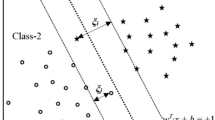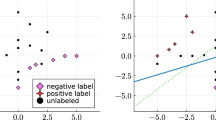Abstract
As an important boundary-based clustering algorithm, support vector clustering (SVC) benefits multiple applications for its capability of handling arbitrary cluster shapes. However, its popularity is degraded by both its highly intensive pricey computation and poor label performance which are due to redundant kernel function matrix required by estimating a support function and ineffectively checking segmers between all pairs of data points, respectively. To address these two problems, a fast and scalable SVC (FSSVC) method is proposed in this paper to achieve significant improvement on efficiency while guarantees a comparable accuracy with the state-of-the-art methods. The heart of our approach includes (1) constructing the hypersphere and support function by cluster boundaries which prunes unnecessary computation and storage of kernel functions and (2) presenting an adaptive labeling strategy which decomposes clusters into convex hulls and then employs a convex-decomposition-based cluster labeling algorithm or cone cluster labeling algorithm on the basis of whether the radius of the hypersphere is greater than 1. Both theoretical analysis and experimental results (e.g., the first rank of a nonparametric statistical test) show the superiority of our method over the others, especially for large-scale data analysis under limited memory requirements.







Similar content being viewed by others
References
Alzate C, Suykens JAK (2010) Multiway spectral clustering with out-of-sample extensions through weighted kernel pca. IEEE Trans Patt Anal Mach Intell 32(2):335–347
Alzate C, Suykens JAK (2011) Sparse kernel spectral clustering models for large-scale data analysis. Neurocomputing 74(9):1382–1390
Ban T, Abe S (2004) Spatially chunking support vector clustering algorithm. In: Proceedings of international joint conference on neural networks, pp 414–418
Ben-Hur A, Horn D, Siegelmann HT, Vapnik VN (2000) A support vector cluster method. In: Proceedings of 15th international conference on pattern recognition, vol 2, Barcelona, Spain, pp 724–727
Ben-Hur A, Horn D, Siegelmann HT, Vapnik VN (2001) Support vector clustering. J Mach Learn Res 2:125–137
Bergmann G, Hommel G (1988) Improvements of general multiple test procedures for redundant systems of hypotheses. In: Multiple Hypotheses Testing, vol 70, pp. 100–115
Boyd S, Vandenberghe L (2009) Convex Optimization. cambridge university press, Cambridge
Burges C (1998) A tutorial on support vector machines for pattern recognition. Data Min Know Dis 2(2):121–167
Camastra F, Verri A (2005) A novel kernel method for clustering. IEEE Trans Patt Anal Mach Intell 27(5):801–805
Chiang JH, Hao PY (2003) A new kernel-based fuzzy clustering approach: Support vector clustering with cell growing. IEEE Trans Fuzzy Syst 11(4):518–527
Estivill-Castro V, Lee I (2000) Amoeba: Hierarchical clustering based on spatial proximity using delaunay diagram. In: Proceedings of the 9th international symposium on spatial data handling, pp 7a.26-7a.4
Estivill-Castro V, Lee I, Murray AT (2001) Criteria on proximity graphs for boundary extraction and spatial clustering. In: Proceedings of the 5th Pacific-Asia conference on knowledge discovery and data mining (PAKDD’01), vol 2035, pp 348–357
Forghani Y, Yazdi HS, Effati S (2012) An extension to fuzzy support vector data description (fsvdd*). Patt Anal Appl 15(3):237–247
Frank A, Asuncion A (2010) UCI machine learning repository. http://archive.ics.uci.edu/ml
Garcia S, Herrera F (2008) An extension on statistical comparisons of classifiers over multiple data sets for all pairwise comparisons. J Mach Learn Res 9:2677–2694
Graven M, DiPasquo D, Freitag D, McCallum A, Mitchell T, Nigam K, Slattery S (1998) Learning to extract symbolic knowledge form the world wide web. In: Proceedings of 15th Nat’l conference for artificial intelligence (AAAI’98), pp 509–516. Madison, Wisconsin
Guo CH, Li F (2011) An improved algorithm for support vector clustering based on maximum entropy principle and kernel matrix. Exp Syst Appl 38(7):8138–8143
Hersh WR, Buckley C, Leone TJ, Hickam DH (1994) Ohsumed: An interactive retrieval evaluation and new large test collection for research. In: Proceedings of 17th annual ACM SIGIR conference, pp 192–201
Hubert PAL (1985) Comparing partitions. J Classif 2:193–218
Hurley J, Garcia-Palacios E, Sezer S (2011) Classifying network protocols: a ‘two-way’ flow approach. IET Commun 5(1):79–89
Jung KH, Kim N, Lee J (2011) Dynamic pattern denoising method using multi-basin system with kernels. Patt Recogn 44(8):1698–1707
Jung KH, Lee D, Lee J (2010) Fast support-based clustering method for large-scale problems. Patt Recogn 43(5):1975–1983
Kim HC, Lee J (2007) Clustering based on gaussian processes. Neural Comput 19(11):3088–3107
Lang K (1995) Newsweeder: Learning to filter netnews. In: Proceedings 12th international conference machine learning (ICML’95), pp 331–339. Tahoe City.
Lee CH, Yang HC (2009) Construction of supervised and unsupervised learning systems for multilingual text categorization. Exp Syst Appl 2–1(36):2400–2410
Lee D, Jung KH, Lee J (2009) Constructing sparse kernel machines using attractors. IEEE Trans Pat Anal Mach Intell 20(4):721–729
Lee D, Lee J (2007) Equilibrium-based support vector machine for semisupervised classification. IEEE Trans Neural Netw 18(2):578–583
Lee J, Lee D (2005) An improved cluster labeling method for support vector clustering. IEEE Trans Patt Anal Mach Intell 27(3):461–464
Lee J, Lee D (2006) Dynamic characterization of cluster structures for robust and inductive support vector clustering. IEEE Trans Patt Anal Mach Intell 28(11):1869–1874
Lee SH, Daniels KM (2005) Gaussian kernel width selection and fast cluster labeling for support vector clustering. Technical Report No. 2005–009, USA
Lee SH, Daniels KM (2005) Cone cluster labeling for support vector clustering. In: Proceedings of 6th SIAM conference on data mining, pp 484–488
Lewis DD (1997) Reuters-21578 text categorization collection. http://kdd.ics.uci.edu/databases/reuters21578/
Li YH (2011) Selecting training points for one-class support vector machines. Patt Recogn Lett 32(11):1517–1522
Li YH, Maguire L (2011) Selecting critical patterns based on local geometrical and statistical information. IEEE Trans Patt Anal Mach Intell 33(6):1189–1201
Ling P, Zhou CG, Zhou X (2010) Improved support vector clustering. Eng Appl Artif Intell 23(4):552–559
Mehrotra S (1992) On the implementation of a primal-dual interior point method. SIAM J Optim 2: 575–601
Peng JF, Zhou YJ, Wang C, Yang YX, Ping Y (2011) Early TCP traffic classification. J Appl Sci Electron Inform Eng 29(1):73–77
Ping Y, Tian YJ, Zhou YJ, Yang YX (2012) Convex decomposition based cluster labeling method for support vector clustering. J Comput Sci Technol 27(2):428–442
Ping Y, Zhou YJ, Xue C, Yang YX (2012) Efficient representation of text with multiple perspectives. J China Uni Posts Telecommun 19(1):101–111
Ping Y, Zhou YJ, Yang YX (2011) A novel scheme for accelerating support vector clustering (in press)
Platt JC (1999) Fast training of support vector machines using sequential minimal optimization. In: Advances in kernel methods: support vector learning. MIT Press, Cambridge
Puma-Villanueva WJ, Bezerra GB, Lima CAM, Zuben FJV (2005) Improving support vector clustering with ensembles. In: Proceedings of international joint conference on neural networks, Montreal, pp 13–15
Scholkopf B, Platt JC, Shawe-Taylor J, Smola AJ, Williamson RC (2001) Estimating the support of a high-dimensional distribution. Neural Comput 13(7):1443–1472
Shamir O, Tishby N (2010) Stability and model selection in k-means clustering. Mach Learn 81(1): 213–243
Sheskin D (2003) Handbook of parametric and nonparametric statistical procedures. Chapman & Hall, London
Su MY (2011) Using clustering to improve the KNN-based classifiers for online anomaly network traffic identification. J Netw Comput Appl 34(2):722–730
Tax DMJ, Duin PRW (1999) Support vector domain description. Patt Recogn Lett 11–13(20):1191–1199
UNIBS: The UNIBS anonymized 2009 internet traces (Mar 18, 2010)
Veenman CJ, Reinders MJT, Backer E (2002) A maximum variance cluster algorithm. IEEE Trans Patt Anal Mach Intell 24(9):1273–1280
Wang CD, Lai JH (2013) Position regularized support vector domain description. Patt Recogn 46(3): 875–884
Wang CD, Lai JH, Huang D, Zheng WS (2012) Svstream: A support vector based algorithm for clustering data streams. IEEE Trans Know Data Eng (in press), 1–14 . doi: 10.1109/TKDE.2011.263
Wang DF, Shi L, Yeung DS, Tsang ECC, Heng PA (2007) Ellipsoidal support vector clustering for functional MRI analysis. Patt Recogn 40(10):2685–2695
Wang JS, Chiang JC (2009) An efficient data preprocessing procedure for support vector clustering. J Univ Comput Sci 15(4):705–721
Wu M, Scholkopf B (2007) A local learning approach for clustering. In: Advances in neural information processing systems (NIPS 2007), vol 19, pp 1529–1536. Vancouver, Canada (2007)
Xu R, Wunsch DC (2008) Clustering. Wiley, Hoboken
Yang JH, Estivill-Castro V, Chalup SK (2002) Support vector clustering through proximity graph modelling. In: Proceedings of 9th international conference on neural information processing (ICONIP’02), pp 898–903. Orchid Country Club, Singapore
Acknowledgments
Useful suggestions from the referees are gratefully acknowledged. This work was supported by the grant from the National High Technology Research and Development Program of China under Grant No. 2009AA01Z430, the grant from the National Natural Science Foundation of China under Grant No. 61303232, 61121061, 60821001, 11271361 and 70921061, the Specialized Research Fund for the Doctoral Program of Higher Education under Grant No. 20120005110017, the Ministry of water resources’ special funds for scientific research on pubic causes under Grant No. 201301094, the Foundation of He’nan Educational Committee under Grant No.13A413750, 13A413747, the Natural Science Foundation of He’nan Province of China under Grant No. 122102210543 and Xuchang Municipal Natural Science Foundation under Grant No. 5018.
Author information
Authors and Affiliations
Corresponding author
Rights and permissions
About this article
Cite this article
Ping, Y., Chang, Y.F., Zhou, Y. et al. Fast and scalable support vector clustering for large-scale data analysis. Knowl Inf Syst 43, 281–310 (2015). https://doi.org/10.1007/s10115-013-0724-9
Received:
Revised:
Accepted:
Published:
Issue Date:
DOI: https://doi.org/10.1007/s10115-013-0724-9




